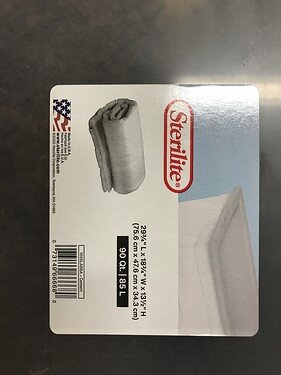I’ve seen people put it in tubs then wet it.
But I don’t do that.
I usually put it in dry, and then dampen it when it looks like any of my snakes are going into shed.
So if you use coco husk, how do you use it?
I personally have made one block of Reptichip and then keep it inside a tote until I need to add substrate to Kai’s enclosure. I have never had molding issues or anything. When I use it still contains enough moisture to be appropriate for Kai’s enclosure.
I have a large tote that I prepare the block and store it in. To prepare it I usually put it in a 5 gallon bucket, add a gallon of water and break it up. (depending on the type of coco block) if it readily breaks up without water being added I’ll just break it up into the large tote and mix it with what I have already in it.
I see.
To both of you, how much does it expand by?
That’s part of the reason why I’m asking.
I feel like I’m wasting my coco husk by doing it the way I’m doing it.
But I’m afraid if i put it in water, it’ll mold or something like that.
Well, coco doesn’t tend to have molding issues, especially if it has airflow to it.
Expansion wise, depends on the type some more than double, some doesn’t seem to expand at all.
The one that I use expandes by a lot. I used reptichip and it filled a 52 L tote with some to spare. About mold, I’ve never had any of it.
What size do you get? I’ve been looking at other options for substrate.
If you’re asking me, I get the freedom breeder 10lb block.
It does last me quite a bit, as one block can be used for at least a month or two.
But that’s because I mostly just had babies.
Now that my snakes are getting bigger, I want be more efficient with it.
I’ve considered switching to coco substrate over paper towels for my non-colubrid species myself, but I’m not sure how much I would need for my collection and how much it would cost compared to paper towels, or even if it’s a necessary option to take.
I was specifically asking @lumpy but this is still helpful.
I use Coco fibre. I pop it into a box and add water. One brick expand quite a bit. I usually use one and quarter per Viv as I like there to be room for them to bury if they want too.
I’ve never had mould issues. Sometimes I’ve kept it in a tub if I’ve made too much, other times in a bag as I use it for my Cresties also
Sorry just seeing this, but I buy this size from Reptichip. Though as I buy more and more due to more breeders coming in I will probably buy some on a pallet. I use them because I hate the dust of coco substrate.
and I was wrong in my post above about 52 L it is really this
Thanks for the link.
I may switch to that brand as well.
Lately, I’ve been finding things in the FB coco husk that I don’t approve of.
If you’re wondering, I’ve been finding bits of plastic string and even a piece of concrete…
So I kinda want to change it to something else.
Thanks for that link. I’ve been wanting to get away from dusty aspen and find something better. I that’s it.
I use the breeder blocks of reptichip. There’s a local vendor that sells them for 20 bucks a brick. I don’t have enough snakes to use all of it and I don’t like keeping it damp. I ended manually breaking the dry brick into chunks and putting it into a storage tote. That way I can just rehydrate what I need.
I use coco type substrate (alternating between Cocoblox and Reptichip) for two of my enclosures. One is a 36X24 (floor dimensions) and the other is a 30X20 (floor dimension) both have a lip approx 3". I break off the amouth I think I need into a tub and wet to expand a bit, add more if needed to layer the cages with an ample amount of substrate. A 10lb block lasts just over 2 changes. It will handle two full changes and there i a bit left over that I can pull from throughout the month if I spot clean an area and want to fill that spot in. Hope this helps
